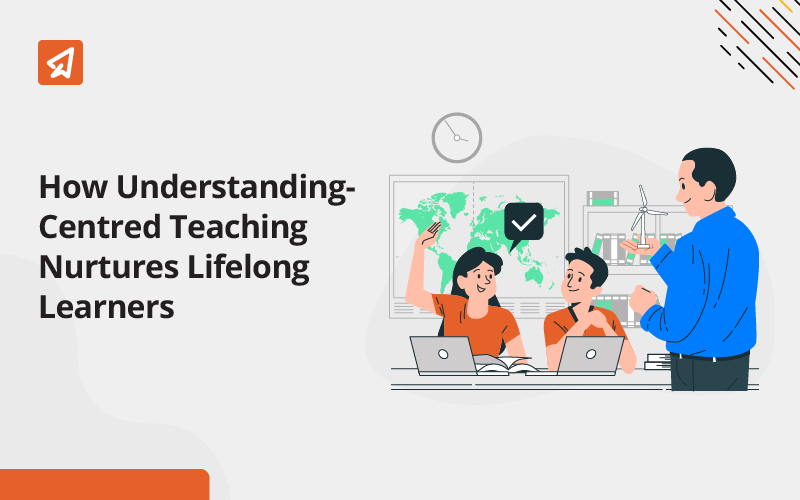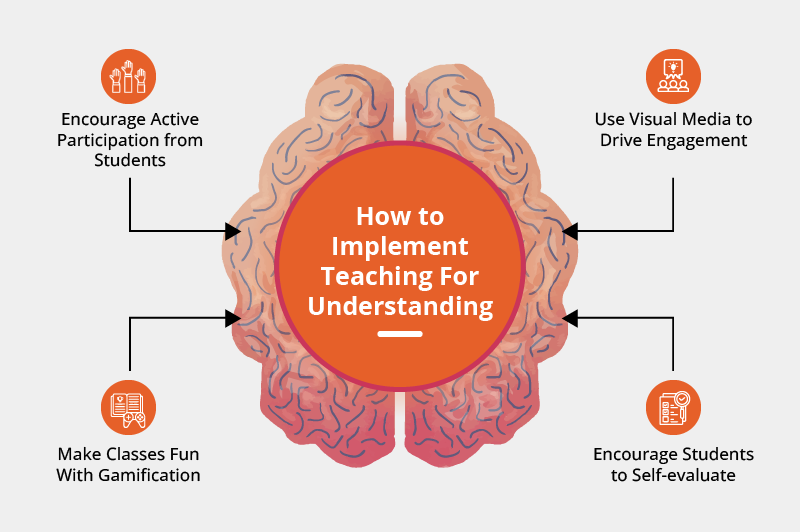How Understanding-Centred Teaching Nurtures Lifelong Learners

Education is about gaining knowledge, learning new skills and developing one’s reasoning. However, practices like rote learning often get in the way of this objective, leaving educational practices hollow. While memorization has always persisted in our educational system, today, a transformation is underway. A new pedagogical approach known as “teaching for understanding” is changing our perception of what it means to learn. Let’s learn more!
Limitations of Rote Memorization
For decades, rote memorization has held a prominent place in education. It involves the repetition of facts and figures to remember them, with little emphasis on comprehension. While it might suffice for short-term knowledge retention, it does not nurture the intellectual growth of students. Often students can flawlessly recall data but struggle to analyse the information at hand. For example, students may recite historical dates and events with ease but cannot understand the causes and effects that shaped the course of history. This is a result of the inherent limitation of rote memorization. Information, divorced from context, becomes a disconnected series of data points rather than a coherent body of knowledge.
Teaching for Understanding
“Teaching for understanding” is a departure from the age-old practice of rote memorization. It encourages educators to prioritise comprehension over memorization. The goal is to equip students with the ability to grasp concepts deeply, enabling them to apply their knowledge flexibly in various contexts. This transformative pedagogical approach acknowledges that educators are not merely disseminators of information but facilitators of understanding. It necessitates a more active role for teachers—one that involves guiding students through the journey of comprehension. To ensure students stay interested and motivated, teaching for understanding requires teachers to bond and connect with their students. This leads to better long-term outcomes towards a student’s performance in the subject.
Strategies for Implementing Teaching for Understanding

Wondering how an educator can transition from rote memorization to teaching for understanding? The answer lies in a diverse set of strategies that foster comprehension and engagement in the classroom.
1. Active Learning
Encouraging students to actively participate in their learning process is a cornerstone of teaching for understanding. This can take various forms, from group discussions and problem-solving activities to hands-on experiments. Digital learning platforms like the Extramarks Teaching App have made Active learning a part of their offerings. Asking questions while they learn the modules, keeps students engaged, encourages them to think critically and ensures retention.
2. Visualisation
Visualisation is an excellent way to help students understand, connect, and retain information. By creating visual representations of concepts, students gain a deeper understanding of complex topics. This approach encourages them to see the bigger picture. Using tools like 3D videos and other multimedia formats from Extramarks Smart Class Plus’ extensive content library, teachers can help students learn visually and retain information better.
3. Gamification
Gamification is one of the most effective ways of making learning more interesting for students. By making learning more fun and interactive, teachers ensure that students will pay attention to what they are studying and retain the concepts better. Tools like the Extramarks Learning app offer features like Interactive learning which gamify complex concepts, making them easier to understand.
4. Self Diagnosis
Students need to evaluate themselves while learning. Self-diagnosis helps them build confidence in their critical thinking and problem-solving abilities and helps them keep track of their proficiency in the subject. Platforms like Extramarks Learning App have diagnostic tools like an analytics dashboard that help students evaluate their performance and track their strengths and weaknesses.
Fostering Critical Thinking Skills
Critical thinking is a central pillar of teaching for understanding. Teachers need to encourage students to analyse information critically. Critical thinking skills play a pivotal role in understanding-focused education. Critical thinking involves evaluating information, considering various perspectives, and making informed judgments. It equips students with the ability to differentiate between reliable and unreliable sources, an essential skill in today’s information age. Teachers can nurture critical thinking by posing open-ended questions, encouraging debates, and challenging students to explore complex issues.
The Impact on Student Engagement
An undeniable correlation exists between understanding-focused education and increased student engagement. When a student is engaged, they are more likely to retain knowledge and apply it properly. Engagement helps teachers ignite their students’ curiosity and motivation. Educators who prioritise understanding witness their students actively participating in discussions, asking insightful questions, and exploring topics beyond the confines of the syllabus. This heightened engagement fosters a deep sense of ownership over their learning journey, which, in turn, contributes to a more profound understanding of the subject matter.
The Role of Technology in Teaching for Understanding
In the digital age, technology plays a pivotal role in enhancing understanding-focused education. In-class digital resources like personal learning devices, interactive smartboards, projectors, and more, have made learning far more interesting and boosted in-class engagement. Another game-changer is digital learning platforms like Extramarks Smart Class Plus. These can help ease the teacher’s burden in developing interesting teaching materials since they already have an extensive content library full of 3D videos, interactive learning materials and an extensive question bank full of various question formats.
What’s more, they also help keep students up to date with their progress using their analytics dashboard providing the necessary transparency to keep students invested in their progress. These tools make complex concepts more accessible and engage students in ways that traditional methods cannot.
Overcoming Challenges and Resistance
As with any paradigm shift in education, challenges inevitably arise. Educators transitioning to teaching for understanding may encounter resistance or logistical obstacles. Let’s learn how we can address these challenges head-on and provide practical solutions.
1. Resistance to Change
As an educator, while you may understand the benefits of teaching for understanding over rote memorization, it is hard to drive change in an educational system set up to benefit the traditional methods. The solution is to advocate for the benefits an understanding-centric approach offers to students. Attend webinars and other online courses to prioritize your own personal growth before you start spreading awareness to other educators.
2. Logistical Issues
Implementing teaching for understanding may require adjustments to curriculum, assessments, and teaching methods. As a teacher, these may be difficult to achieve by yourself. To achieve this change, you can collaborate with other educators from your institute by advocating for the benefits of this approach. You can also use digital resources like Extramarks Smart Class Plus to make the adjustment easier.
3. Measurement and Assessment
Traditional assessment methods may not effectively evaluate understanding. Educators can explore alternative assessment techniques, such as the ones available on platforms like the Extramarks Teaching app. Their extensive question bank makes setting papers extremely easy and automated evaluation takes away the added workload of paper correction from teachers.
Nurturing Lifelong Learners
Beyond the immediate benefits of understanding-focused education lies a profound outcome—the cultivation of lifelong learners. Students who grasp concepts instead of memorising them develop a love for learning that extends far beyond the classroom. They grow into curious individuals who seek knowledge not because they have to but because they want to. They are armed with the ability to tackle new challenges, adapt to evolving technologies, and thrive in a rapidly changing world. These individuals are future innovators, problem solvers, and leaders who will transform industries and drive future progress. Their journeys often begin with educators who prioritise teaching for understanding.
In the modern educational landscape, “teaching for understanding” is here to play a transformative role. It transcends the limitations of rote memorization, nurturing students’ ability to comprehend, apply, and adapt knowledge. Educators who embrace this approach become facilitators of understanding, guiding students on a journey of discovery. Start your journey as an educator who practises teaching for understanding in your very own classroom. Extramarks Smart Class Plus has several features that can help you make the interventions necessary to adopt this new philosophy. Get started today!
Last Updated on February 17, 2025
Reviewed by

Prachi Singh | VP - Academics
Prachi Singh is a highly accomplished educationist with over 16 years of experience in the EdTech industry. Currently, she plays a pivotal role at Extramarks, leading content strategy and curriculum development initiatives that shape the future of education...read more.










